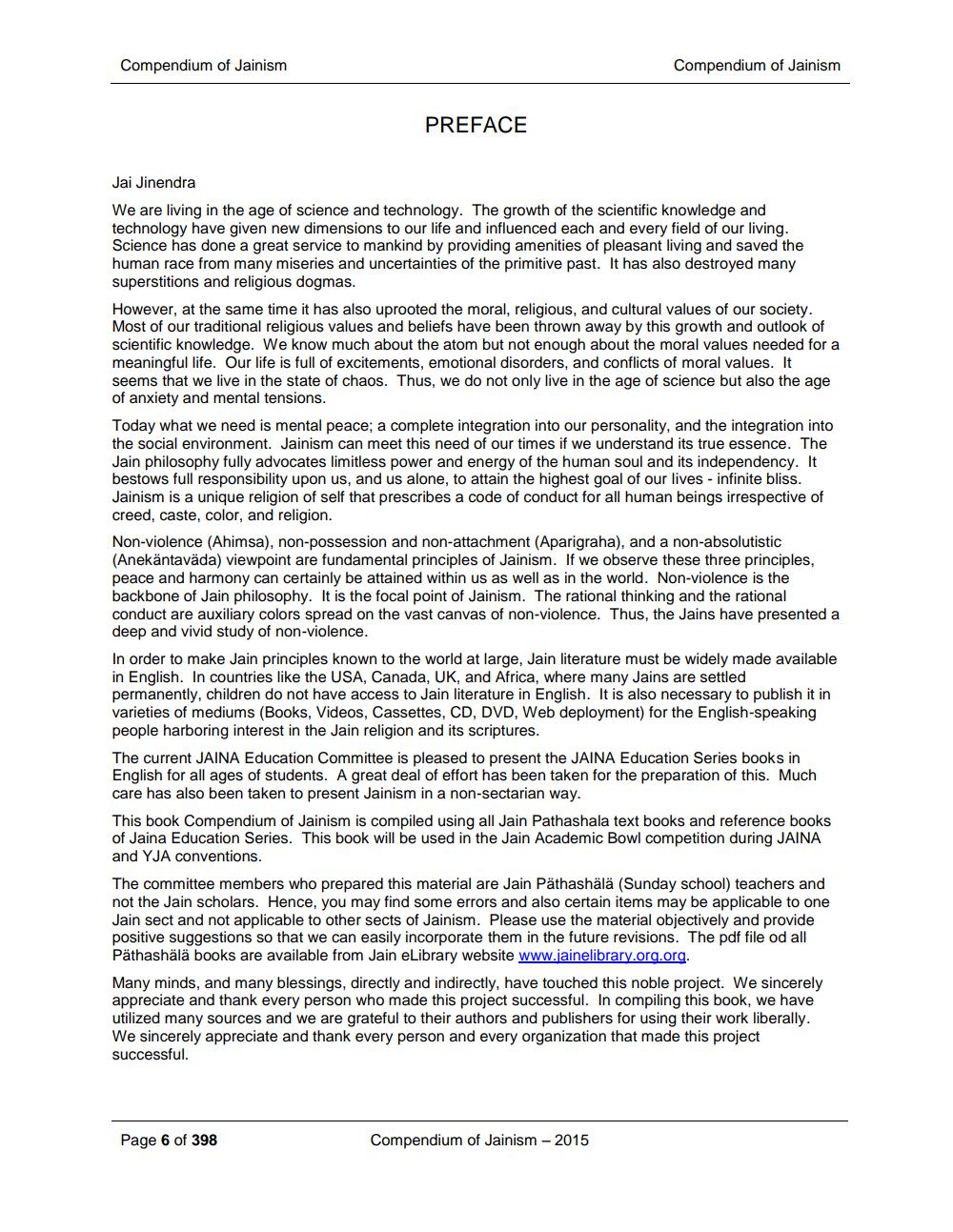Book Title: $JES 904 Compendium of Jainism (Jain Academic Bowl Manual 3rd Edition) Author(s): JAINA Education Committee Publisher: JAINA Education Committee View full book textPage 6
________________ Compendium of Jainism Compendium of Jainism PREFACE Jai Jinendra We are living in the age of science and technology. The growth of the scientific knowledge and technology have given new dimensions to our life and influenced each and every field of our living. Science has done a great service to mankind by providing amenities of pleasant living and saved the human race from many miseries and uncertainties of the primitive past. It has also destroyed many superstitions and religious dogmas. However, at the same time it has also uprooted the moral, religious, and cultural values of our society. Most of our traditional religious values and beliefs have been thrown away by this growth and outlook of scientific knowledge. We know much about the atom but not enough about the moral values needed for a meaningful life. Our life is full of excitements, emotional disorders, and conflicts of moral values. It seems that we live in the state of chaos. Thus, we do not only live in the age of science but also the age of anxiety and mental tensions Today what we need is mental peace; a complete integration into our personality, and the integration into the social environment. Jainism can meet this need of our times if we understand its true essence. The Jain philosophy fully advocates limitless power and energy of the human soul and its independency. It bestows full responsibility upon us, and us alone, to attain the highest goal of our lives - infinite bliss. Jainism is a unique religion of self that prescribes a code of conduct for all human beings irrespective of creed, caste, color, and religion. Non-violence (Ahimsa), non possession and non-attachment (Aparigraha), and a non-absolutistic (Anekantaväda) viewpoint are fundamental principles of Jainism. If we observe these three principles, peace and harmony can certainly be attained within us as well as in the world. Non-violence is the backbone of Jain philosophy. It is the focal point of Jainism. The rational thinking and the rational conduct are auxiliary colors spread on the vast canvas of non-violence. Thus, the Jains have presented a deep and vivid study of non-violence. In order to make Jain principles known to the world at large, Jain literature must be widely made available in English. In countries like the USA, Canada, UK, and Africa, where many Jains are settled permanently, children do not have access to Jain literature in English. It is also necessary to publish it in varieties of mediums (Books, Videos, Cassettes, CD, DVD, Web deployment) for the English-speaking people harboring interest in the Jain religion and its scriptures. The current JAINA Education Committee is pleased to present the JAINA Education Series books in English for all ages of students. A great deal of effort has been taken for the preparation of this. Much care has also been taken to present Jainism in a non-sectarian way. This book Compendium of Jainism is compiled using all Jain Pathashala text books and reference books of Jaina Education Series. This book will be used in the Jain Academic Bowl competition during JAINA and YJA conventions. The committee members who prepared this material are Jain Päthashälä (Sunday school teachers and not the Jain scholars. Hence, you may find some errors and also certain items may be applicable to one Jain sect and not applicable to other sects of Jainism. Please use the material objectively and provide positive suggestions so that we can easily incorporate them in the future revisions. The pdf file od all Päthashälä books are available from Jain eLibrary website www.jainelibrary.org.org. Many minds, and many blessings, directly and indirectly, have touched this noble project. We sincerely appreciate and thank every person who made this project successful. In compiling this book, we have utilized many sources and we are grateful to their authors and publishers for using their work liberally. We sincerely appreciate and thank every person and every organization that made this project successful. Page 6 of 398 Compendium of Jainism - 2015Page Navigation
1 ... 4 5 6 7 8 9 10 11 12 13 14 15 16 17 18 19 20 21 22 23 24 25 26 27 28 29 30 31 32 33 34 35 36 37 38 39 40 41 42 43 44 45 46 47 48 49 50 51 52 53 54 55 56 57 58 59 60 61 62 ... 400
